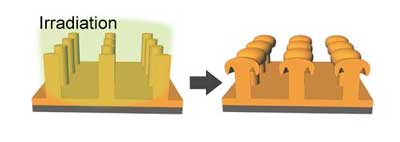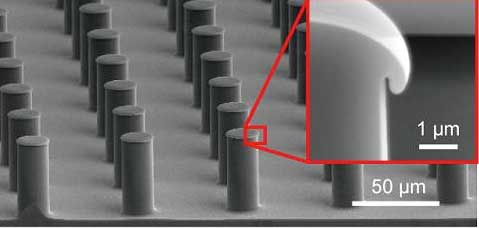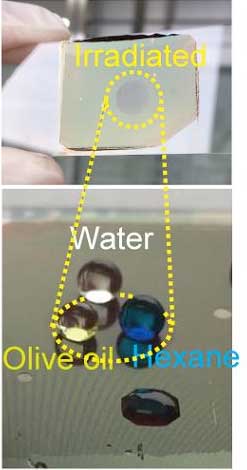| Posted: Sep 11, 2017 |
A novel and practical fab-route for superomniphobic liquid-free surfaces
(Nanowerk News) A joint research team led by Professor Hee Tak Kim and Shin-Hyun Kim in the Department of Chemical and Biomolecular Engineering at The Korea Advanced Institute of Science and Technology (KAIST) developed a fabrication technology that can inexpensively produce surfaces capable of repelling liquids, including water and oil (ACS Nano, "Flexible and Robust Superomniphobic Surfaces Created by Localized Photofluidization of Azopolymer Pillars").
|
|
The team used the photofluidization of azobenzene molecule-containing polymers to generate a superomniphobic surface which can be applied for developing stain-free fabrics, non-biofouling medical tubing, and corrosion-free surfaces.
|
 |
| Schematic Diagram of Mushroom-Shaped Structure Fabrication. (Image: KAIST)
|
|
Mushroom-shaped surface textures, also called doubly re-entrant structures, are known to be the most effective surface structure that enhances resistance against liquid invasion, thereby exhibiting superior superomniphobic property.
|
|
However, the existing procedures for their fabrication are highly delicate, time-consuming, and costly. Moreover, the materials required for the fabrication are restricted to an inflexible and expensive silicon wafer, which limits the practical use of the surface.
|
|
To overcome such limitations, the research team used a different approach to fabricate the re-entrant structures called localized photofludization by using the peculiar optical phenomenon of azobenzene molecule-containing polymers (referred to as azopolymers). It is a phenomenon where an azopolymer becomes fluidized under irradiation, and the fluidization takes place locally within the thin surface layer of the azopolymer.
|
 |
| SEM Image of Mushroom-Shaped Structure. (Image: KAIST)
|
|
With this novel approach, the team facilitated the localized photofluidization in the top surface layer of azopolymer cylindrical posts, successfully reconfiguring the cylindrical posts to doubly re-entrant geometry while the fluidized thin top surface of an azopolymer is flowing down.
|
|
The structure developed by the team exhibits a superior superomniphobic property even for liquids infiltrating the surface immediately.
|
|
Moreover, the superomniphobic property can be maintained on a curved target surface because its surficial materials are based on high molecules.
|
|
Furthermore, the fabrication procedure of the structure is highly reproducible and scalable, providing a practical route to creating robust omniphobic surfaces.
|
 |
| Image of superomniphobic property of different types of liquid. (Image: KAIST)
|
|
Professor Hee Tak Kim said, "Not only does the novel photo-fluidization technology in this study produce superior superomniphobic surfaces, but it also possesses many practical advantages in terms of fab-procedures and material flexibility; therefore, it could greatly contribute to real uses in diverse applications."
|
|
Professor Shin-Hyun Kim added, "The designed doubly re-entrant geometry in this study was inspired by the skin structure of springtails, insects dwelling in soil that breathe through their skin. As I carried out this research, I once again realized that humans can learn from nature to create new engineering designs."
|



